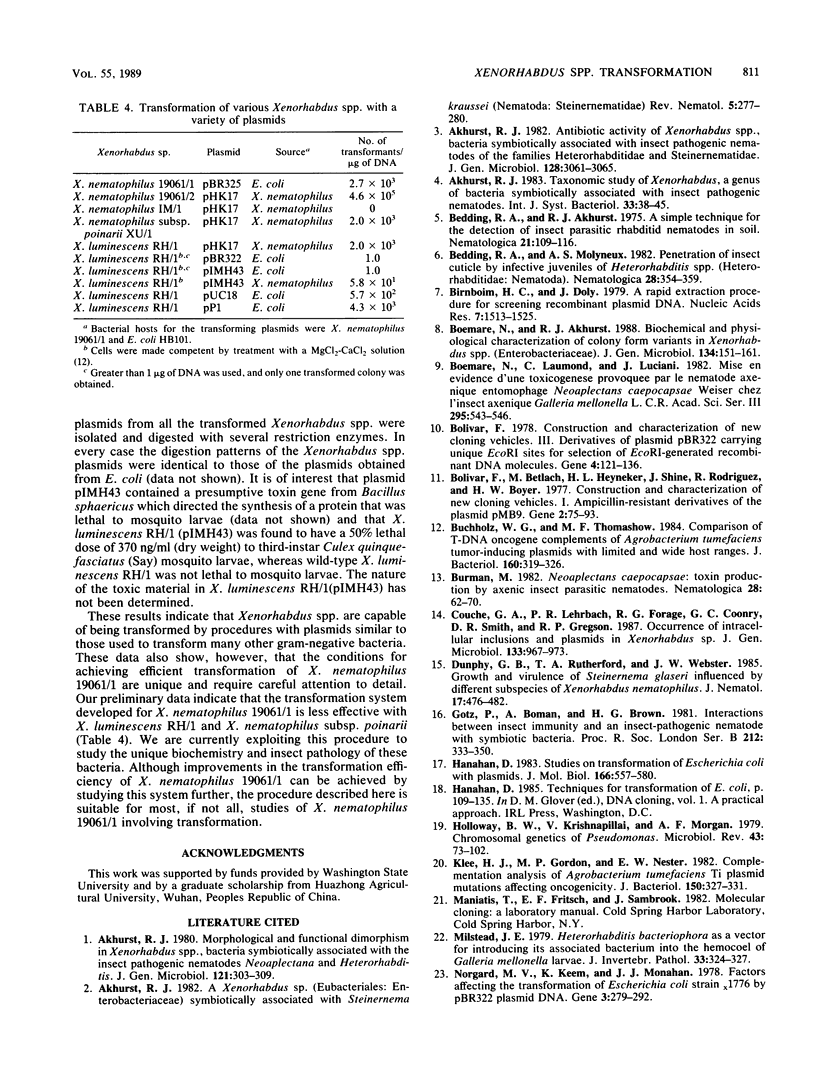Abstract
The ability of Xenorhabdus nematophilus 19061/1 to be transformed by pHK17 plasmid DNA was studied and optimized. A number of factors, including culture conditions, stage of growth, transformation buffer pH, cation type and concentration required for the production of competency, washing, heat shock conditions, and cell-DNA ratio, were found to affect transformation significantly. On the basis of these observations, a procedure for the routine transformation of X. nematophilus 19061/1 at frequencies of 1 X 10(5) to 10 X 10(5) transformants per microgram of pHK17 plasmid DNA was developed. Maximum transformation was obtained when cells which had reached the mid- to late-logarithmic growth phase (total counts, 2.5 X 10(8) to 5 X 10(8) cells per ml) within 4.5 to 5.5 h were washed once in cold transformation buffer before they were suspended in the same buffer to 0.1 of their original volume. The highest transformation was obtained when dimethyl sulfoxide was added in two steps to the cells immediately before the DNA was added, after which the cell-DNA mixtures were incubated for 30 min on ice before they were given a 3-min heat shock at 37 degrees C. Following these treatments, the transformed cells were incubated in L broth-60 mM CaCl2 for 1 h before they were plated onto selective medium. We also were able to transform X. nematophilus 19061/1 with plasmid pBR325, and we transformed other species of Xenorhabdus with several common plasmids.
Full text
PDF






Selected References
These references are in PubMed. This may not be the complete list of references from this article.
- Akhurst R. J. Antibiotic activity of Xenorhabdus spp., bacteria symbiotically associated with insect pathogenic nematodes of the families Heterorhabditidae and Steinernematidae. J Gen Microbiol. 1982 Dec;128(12):3061–3065. doi: 10.1099/00221287-128-12-3061. [DOI] [PubMed] [Google Scholar]
- Birnboim H. C., Doly J. A rapid alkaline extraction procedure for screening recombinant plasmid DNA. Nucleic Acids Res. 1979 Nov 24;7(6):1513–1523. doi: 10.1093/nar/7.6.1513. [DOI] [PMC free article] [PubMed] [Google Scholar]
- Bolivar F. Construction and characterization of new cloning vehicles. III. Derivatives of plasmid pBR322 carrying unique Eco RI sites for selection of Eco RI generated recombinant DNA molecules. Gene. 1978 Oct;4(2):121–136. doi: 10.1016/0378-1119(78)90025-2. [DOI] [PubMed] [Google Scholar]
- Bolivar F., Rodriguez R. L., Betlach M. C., Boyer H. W. Construction and characterization of new cloning vehicles. I. Ampicillin-resistant derivatives of the plasmid pMB9. Gene. 1977;2(2):75–93. doi: 10.1016/0378-1119(77)90074-9. [DOI] [PubMed] [Google Scholar]
- Buchholz W. G., Thomashow M. F. Comparison of T-DNA oncogene complements of Agrobacterium tumefaciens tumor-inducing plasmids with limited and wide host ranges. J Bacteriol. 1984 Oct;160(1):319–326. doi: 10.1128/jb.160.1.319-326.1984. [DOI] [PMC free article] [PubMed] [Google Scholar]
- Hanahan D. Studies on transformation of Escherichia coli with plasmids. J Mol Biol. 1983 Jun 5;166(4):557–580. doi: 10.1016/s0022-2836(83)80284-8. [DOI] [PubMed] [Google Scholar]
- Holloway B. W., Krishnapillai V., Morgan A. F. Chromosomal genetics of Pseudomonas. Microbiol Rev. 1979 Mar;43(1):73–102. doi: 10.1128/mr.43.1.73-102.1979. [DOI] [PMC free article] [PubMed] [Google Scholar]
- Klee H. J., Gordon M. P., Nester E. W. Complementation analysis of Agrobacterium tumefaciens Ti plasmid mutations affecting oncogenicity. J Bacteriol. 1982 Apr;150(1):327–331. doi: 10.1128/jb.150.1.327-331.1982. [DOI] [PMC free article] [PubMed] [Google Scholar]
- Norgard M. V., Keem K., Monahan J. J. Factors affecting the transformation of Escherichia coli strain chi1776 by pBR322 plasmid DNA. Gene. 1978 Jul;3(4):279–292. doi: 10.1016/0378-1119(78)90038-0. [DOI] [PubMed] [Google Scholar]
- Poinar G. O., Jr, Thomas G. M. Significance of Achromobacter nematophilus Poinar and Thomas (Achromobacteraceae: Eubacteriales) in the development of the nematode, DD-136 (Neoaplectana sp. Steinernematidae). Parasitology. 1966 May;56(2):385–390. doi: 10.1017/s0031182000070980. [DOI] [PubMed] [Google Scholar]
- Stray J. E., Klowden M. J., Hurlbert R. E. Toxicity of Bacillus sphaericus crystal toxin to adult mosquitoes. Appl Environ Microbiol. 1988 Sep;54(9):2320–2321. doi: 10.1128/aem.54.9.2320-2321.1988. [DOI] [PMC free article] [PubMed] [Google Scholar]
- Vieira J., Messing J. The pUC plasmids, an M13mp7-derived system for insertion mutagenesis and sequencing with synthetic universal primers. Gene. 1982 Oct;19(3):259–268. doi: 10.1016/0378-1119(82)90015-4. [DOI] [PubMed] [Google Scholar]
- Wabiko H., Raymond K. C., Bulla L. A., Jr Bacillus thuringiensis entomocidal protoxin gene sequence and gene product analysis. DNA. 1986 Aug;5(4):305–314. doi: 10.1089/dna.1986.5.305. [DOI] [PubMed] [Google Scholar]


